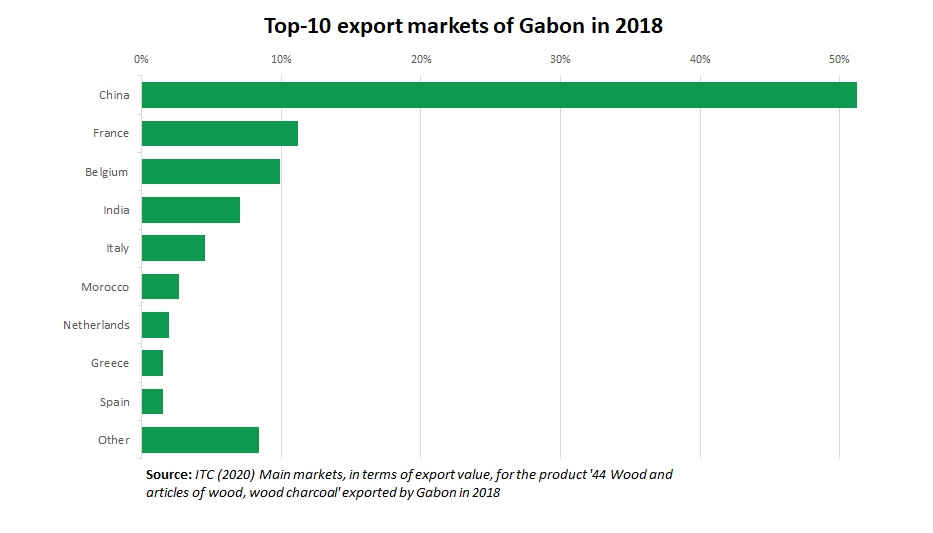Overview of timber sector of Gabon
Forest concessions
(2019)
Log exports
Number of processing units (2020)
million m3 produced in 2016 (log equivalent)
Supply chain actors
The forest code makes it mandatory to manage allocated forest concessions and to process timber. It also provides for three types of forest permits, the Concession Forestière sous Aménagement Durable (CFAD), the Permis Forestier Associé (PFA), the Permis de Gré à Gré (PGG) and the Forêts Communautaires (UFIGA, 2020). In 2019, the number of Community Forests under Final Agreement was 51 for a surface area of 259,883 ha. While those under Provisional Agreement numbered 41 and covered an area of 113,454 ha. In the same year, there were 97 forest concessions, including 12,739,939 ha under forest management (UFIGA, 2020).
With the 2009 ban on log exports and the obligation for log producers to process theirproduct on site, three types of operators can now be distinguished in Gabon:
- Those that are integrated from the forest concession to the processing plant, often with a good commercial capacity for export. They produce and process almost all of their log production. They also sell logs to the other local processors;
- Logging companies without a processing plant that only specialise in logging (logging operations alone). They are perhaps the ones that initially suffered most from the consequences of the log export ban;
- Industrial loggers, who have their own processing plant but no forest concession. There are many of them today and this is a major regional development. They may encounter difficulties procuring logs.
Production and processing
Main harvested species
Among the species currently harvested, there are mainly 24 species:
- Abura (Fleroyaledermannii)
- Acajou (Khayaivorensiset Khayaanthotheca)
- Andoung (Monopetalanthus spp, Tetraberliniapolyphylla and Toubaouatebrevipaniculata)
- Azobé (Lophiraalata)
- Beli Brun and Beli Rouge (Julbernardia pellegriniana)
- Bilinga (Nauclea diderrichii)
- Bossé clair (Guareacedrataet Guarealaurentii)
- Dabema (Piptadenia strumafricanum)
- Dibetou (Lovoatrichilioïdes)
- Doussié (Afzeliabipindensiset A. pachyloba)
- Iroko (Miliciaexcelsa)
- Izombé (Testuleagabonensis)
- Kosipo (Entandrophragmacandollei)
- Movingui (Distemonanthus benthamianus)
- Niové (Staudtia spp.)
- Okan (Cylicodiscus gabunensis)
- Okoumé (Aucoumeaklaineana)
- Ovengkol (Guibourtiaehie)
- Padouk (Pterocarpus soyauxii)
- Sapelli (Entandrophragma cylindricum)
- Tali (Erythrophleum ivorense)
- Tola (Gossweilerodendron balsamiferum)
- Zingana (Microberlinia brazzavillensis)
Okoumé is the "flagship" species of Gabon's production, accounting for over 60% of the logs produced there.
According to the August 2018 study conducted by FRM entitled "FAC-2030: a strategic vision and the industrialisation of Central Africa's timber sector through 2030", it appears that:
- Gabon is a significant Congo Basin log producer, accounting for 23% of the region's production, behind Cameroon 44% and Congo 24%.
- The ban on log exports has caused national production to fall from 3 million m³ in the early 2000s to 1.5/1.6 million m³ currently.
Industrial production in Gabon is very clearly dominated by sawn timber (accounting for over 70% of production) but Gabon stands out from the other countries of the Sub-Region thanks to its relatively significant production of plywood/veneers (Gabon is a top 5 world exporter of tropical timber veneers).
The number of timber processing units has increased from 82 plants in 2009 to 162 plants in 2017/2018, or 80 plants implanted during the last 8 years. This trend has continued with the installation of additional processing units, bringing the total number to 197 units in 2020 with 70 units installed in the Nkok Special Economic Zone (SEZ). (Central Africa Forest Observatory (OFAC) - Years 2015 to 2017, DGF cited in the August 2018 FRMi study). It should be noted that timber processing units with Asian capital have increased the most, at the expense of processing units with European capital.
The industrial players producing the largest volumes of processed timber in Gabon: in addition to the Rougier Group, two companies, CORA WOOD and PWG-CEB, each produce over 65,000 m³ of processed timber per year (2017 data).
The other main timber processors have volumes of around 20,000 m³ per year. Industrial timber production increased from 600,000 m³ in 2007 to almost 800,000 m³ in 2016, an increase of almost 35%.
Export
In 2009, the Gabonese government decided to completely ban log exports. This measure was implemented in 2010. Industrial production volumes exported are dominated by the sawn timber segment (over 85% of sawn timber produced in Gabon is exported).
Prior to the log export ban decision, forest product exports were clearly dominated by logs, shipped mainly to Asian countries.
After the log export ban, processed timber exports to Asian countries initially declined (from 2009 to 2010), and then export volumes gradually increased until 2013, with a period of stagnation observed from 2013 to 2014.
Currently, over 40% of timber product exports are destined for China. Europe imports around 30% of industrial timber production.

Logistics infrastructure
In terms of logistical infrastructures, Gabon has two main ports for timber exports:
- The port of Port-Gentil
- The port of Owendo (near the capital, Libreville)
The country also has sites under customs authority, which are used to transport forest productstowards the port of Owendo. These are:
- The dry port of Franceville
- The hub in Lastourville
And the Nkok SEZ (a Special Economic Zone with a one-stop counter)
Data table
| Production (X 1000m3) |
Imports (X 1000m3) |
Domestic consumption (X 1000m3) |
Exports (X 1000m3) |
|
|---|---|---|---|---|
| logs | 2.320 | 0 | 2.292 | 28 |
| Sawnwood | 801 | 0 | 138 | 664 |
| Veneer | 271 | 0 | 129 | 143 |
| Plywood | 64 | 1 | 32 | 33 |
ITTO (2019), data 2017


